The amazing Qatari boom - housing prices continue to surge
Property prices in Qatar continue to rise rapidly. The nationwide real estate price index soared by 23.2% during the year to Q2 2015, according to the Qatar Central Bank (QCB). During the latest quarter real estate prices rose by 4.7% (Q2 2015), supported by rapid economic and population growth, and a construction boom in preparation for the 2022 FIFA World Cup.
The value of real estate transactions rose by 18% y-o-y to QAR36 billion (US$9.8 billion) in the first half of 2015, and has almost tripled over the last five years.
At the Porto-Arabia Pearl, the first phase of The Pearl-Qatar, which has a total of 31 towers:
- In the primary market, the average apartment sales price rose by 7% to QAR17,000 (US$4,669) per sq. m. in Q3 2015 from the same period two years ago, according to real estate firm DTZ Qatar .
- In the secondary market, apartments were sold for up to QAR15,000 (US$4,120) in Q3 2015, up by about 15% from two years ago.
“Prices have continued to rise in The Pearl-Qatar, especially for most studio, one and two-bedroom units,” says Dan Strutt of real estate agency LS. “It is a city in itself and being a freehold zone, it is a lifestyle location,” added Strutt. Residential properties in The Pearl-Qatar now sell for more than QAR10,000 (US$2,747) per sq. m.
Even prices of affordable housing are rising rapidly. In Barwa City, house prices rose by 46% y-o-y during the first half of 2015, according to local daily The Peninsula.
There has also been a significant rise in mortgage valuation applications, fuelled by expatriate homebuyers in freehold areas. Real estate loans rose by 10.8% y-o-y to March 2015 to QAR94.32 billion (US$25.91 billion), according to the QCB.
The crash and after
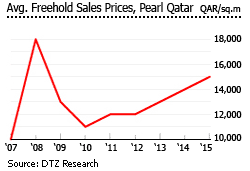
In 2009 housing prices in Qatar fell by as much as 40%, while residential rents dropped about 25%, due to the global financial meltdown. according to Century 21 Qatar . Then in 2010, housing prices fell again by about 4%, according to Saudi-based banking firm, Samba Financial Group .
Prices started to stabilize in 2011, thanks to spectacular economic growth. From 2012 to 2014, the property market expanded strongly, mainly due to rapid population growth caused by the steady job growth in non-hydrocarbon sectors such as finance, hotels, restaurants, and trade and transport. The country’s population reached 2.37 million in May 2015, up by 9.2% from the same period last year, reflecting the large influx of expatriates.
A boom propelled by permanent residence visas
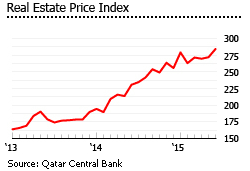
Qatar issues permanent residence visas to foreigners buying freehold properties, under Law No. 17 of 2004, which permitted foreign freehold property ownership for the first time. A property boom followed from mid-2000s to early-2008. Three areas have been set aside for the visas-for-sale scheme: the Pearl-Qatar, West Bay Lagoon and Al Khor Resort.
The visa remains valid as long as the foreigner keeps the property in his name. Foreigners and expatriate residents account for about three-fourths of the population, according to the Qatar Statistics Authority (QSA). About 82% of the population lives in Doha and Al Rayyan.
“With Qatar’s population growth set to increase by over 7 percent per annum in the coming years, the real estate market will need to expand more quickly to keep pace and avoid overheating the market,” said Johnny Archer of DTZ Qatar. GDP growth is expected to rise at 6.5% per year for the next two years, with a continuous influx of expatriate workers.
Yields are excellent, rents are rising strongly
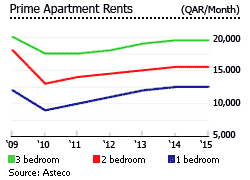
Gross rental yields in Qatar stand at around 10%, according to Alpen Capital, an investment bank.
Rents rose by 7.3% y-o-y in 2014, according to the government. During the first half of 2015 apartment rents have risen again between 5% and 10% y-o-y in selected developments, according to DTZ. Rents have risen specially strongly in the mid-range apartment segment, particularly around Al Sadd area. About 59% of all occupied housing units in Qatar are rented, according to QSA. The average expat household in Qatar spends more than a third of its annual income on rent, according to Colliers International.
Prime location rents, third quarter of 2015:
- One-bedroom apartments rent for around QAR12,000 (US$3,296) to QAR13,000 (US$3,571) per month.
- Two-bedroom apartments rent for around QAR14,000 (US$3,845) to QAR16,000 (US$4,395) per month.
- Three-bedroom apartments rent for around QAR18,000 (US$4,944) to QAR20,000 (US$5,493) per month.
“As Qatar’s economy continues to diversify away from the hydrocarbon exports sector, which currently accounts for approximately 40% of total GDP, inflation in the residential housing market has seen rents increase due to an undersupply of good quality accommodation. DTZ forecasts that this trend is likely to continue into 2016,” said Mark Proudley of DTZ Qatar.
Interest rates unchanged
Overnight lending and repo rate were 4.5%, and the overnight deposit rate was 0.75% in September 2015.
Qatar National Bank (QNB), the country´s leading financial institution, offers home and land financing at rates as low as 4.35%. The maximum loan offered to expatriates is QAR3 million (US$823,280) with a term of not more than 15 years.
The size of Qatar’s mortgage market is estimated at about 14% of GDP. To develop it, Qatar Chamber of Commerce and Industry is drafting the country’s first mortgage law.
The squeeze is on non-elite expats
The number of prime residential units is expected to increase by 40% this year, according to DTZ Research. In 2015, more than 700 new units in Porto Arabia on the Pearl-Qatar are set to be handed over to homebuyers, according to DTZ.
On the other hand, the number of mid-income homes is expected to increase by just 12%.
"Land prices make it difficult to develop low- to middle-income housing and in some areas speculators have pushed up prices to levels where it´s not financially viable to develop any kind of property there," said Proudley.
"There´s an accommodation shortage across all sectors, but it´s probably felt most keenly in the lower- to middle-income segment,” he added. And because of the shortage of affordable housing, middle-class tenants are likely to continue to face higher rent increases than the rate of inflation in coming months.
Land prices are surging
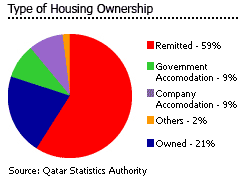
Massive construction in preparation for the 2022 FIFA World Cup continues to push up land prices. Al Shamal, home to the Al-Shamal Stadium - has seen very steep land price increases in the past four years. Dafna, West Bay and The Pearl registered land price increases of around 40% to 50% from two years ago. In Central Doha and Al Rayyan, land prices have risen between 30% and 35% over the same period. Land prices also increased moderately in South Doha and Umm Salal and in the previously underdeveloped Al Wakra and Al Daayen regions.
“Land prices appear to have increased at the fastest pace, followed by villas, where land is typically the most important cost component,” according to an IMF report.
Land accounts for about half of the total value of real estate sales in Qatar every year, about 10 times higher than its proportion in developed markets, according to local property experts.
About 10 years ago, 500 sq.m. land on the outskirts of Doha sold for just QAR200,000 (US$54,932). In 2014, land in the Al Mirqab area was worth QAR151,000 (US$41,473) per sq. m., while land in Doha’s Old Ghanem neighborhood was worth QAR207,000 (US$56,854) per sq. m..
Foreigners can buy in 3 massive freehold areas:
The Pearl-Qatar
The Pearl is a QAR36.4 billion (US$10 billion) Riviera-style development, on a vast man-made island off the coast of Doha, the capital city. It provides over 40 kilometres of new coastline, linked to the mainland by a 4-lane, palm-tree lined highway. Doha´s international airport is only 20 km away. It was here that Qatar offered its first freehold properties.
Developed by the United Development Company, The Pearl-Qatar has 16,000 villas and 25,000 apartments.
West Bay Lagoon
West Bay Lagoon is a 2 million sq. m. private beachfront compound, centred on the Zigzag Towers. At the northern tip of Doha’s West Bay district, it is surrounded by artificial lagoons.
Barwa - Al Khor City
The Barwa - Al Khor project is a complete city, including seafront chalets, villas and elite apartments, covering 5.5 million sq. m. in Al Khor, 57 km north of Doha. The QAR30 billion (US$8.24 billion) Barwa Real Estate development will house 63,000 residents in 24,114 elite residential units. It also has hotels and sports facilities.
There are also 18 leasehold for foreigners
Foreigners can alternatively buy leasehold property for 99 years, renewable, in 18 designated areas, including the multi-billion dollar Lusail project, under Cabinet Decision No. 6 of February 2006. Foreigners can use the properties commercially or residentially, transfer the lease to another party, and sublet or rent.
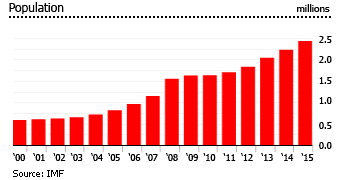
Lusail City is an QAR164 billion (US$45 billion) waterfront community on the northern coast of Umm Salal, 15 km north of Doha. It is expected to house over 200,000 residents in 10 hotels, 3,000 villas, 12,000 apartments and retail areas.
Developed by Qatari Diar, Lusail will cover an area of around 21 million sq. m. This mega project, in 16 zones, will contain an Energy City costing QAR9.5 billion (US$2.6 billion), and an Entertainment City, costing QAR5.5 billion (US$1.5 billion). The Lusail Iconic Stadium is also expected to be built in the city. The massive development is planned to be completed by 2020.
Another mixed use development project is Al Waab City, owned by Nasser Bin Khaled Group, which covers about 1.2 million sq. m. Incorporating “green strategies” and sustainable design principles, it is estimated to cost QAR13 billion (US$3.6 billion). The development includes 2,411 residential units, 232,715 sq. m. of commercial space, and a 425 room hotel complex. Al Waab City is slated to be finished in 2015.
Another notable development is Asia Towers, which will have four 55-storey towers near West Bay. Each tower will contain about 1,600 residential apartments. Developed by Ezdan Real Estate Company, it is estimated to cost QAR2.5 billion (US$686 million).
Other leasehold property developments in Qatar:
- Musheireb (Area #13)
- Frij Abdul Aziz (Area #14)
- Doha Jadeed (Area #15)
- Ghanem Al Qadeem (Area #16)
- Al Rifa Al Hitmi (Area #17)
- Al Salata (Area #18)
- Bin Mahmoud (Area #22)
- Bin Mahmoud (Area #23)
- Rawdat Al Khail (Area #24)
- Al Mansoura & Bin Dirham (Area #25)
- Najma (Area #26)
- Umm Ghuwailina (Area #27)
- Al Khulaifat (north and south) (Area #28)
- Al Sadd (Area #38)
- New Mirqab & Al Nasser (Area #39)
- Doha International airport (Area #48)
- Al Dafna & Onaiza & Al Qitar (Area #60 & 61 & 63)
- Al Kharaij & Jebel Thiya (Area #69 & 70)
Economic growth was slowed enormously, but is still very strong
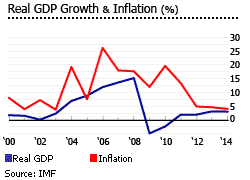
It is amazing to recall the mid-2000s and how rapidly Qatar was growing. Its economy grew by an annual average of 21% from 2006 to 2008!
And despite the global crisis, there were further spectacular growth rates of 12% in 2009, 19.6% in 2010, and 13.4% in 2011.
Economic growth since slowed sharply - to 4.9% in 2012, mainly due to a self-imposed moratorium on new hydrocarbon projects, to conserve resources. After expanding by 4.6% in 2013, Qatar’s economy grew by just 4% in 2014, mainly due to a decline in oil prices.
The economy is projected to grow by 6.5% per year for the next two years.
"Real economic growth, despite lower oil prices, is expected to remain strong in 2015 on the back of vigor in the non-hydrocarbon economy that is set to carry through to 2016 and 2017, before it moderates," said the Ministry of Development Planning and Statistics.
The budget deficit surged to 10.1% of GDP in Q1 2015, in sharp contrast with the surplus of 21.2% of GDP in Q4 2014, according to the QCB.
Inflation slowed to 1% in Q2 2015, according to the QCB. After annual inflation of 13.5% from 2006 to 2008, consumer prices fell by an average of 3.6% per year from 2009 to 2010.
Unemployment dropped to 0.2% in 2014, from 0.3% in 2013, 0.5% in 2012, and 0.6% 2011, the lowest in the Middle East, according to Qatar Statistics Authority (QSA). Qatar’s highest-ever unemployment rate was 3.9%, seen in December 2011.